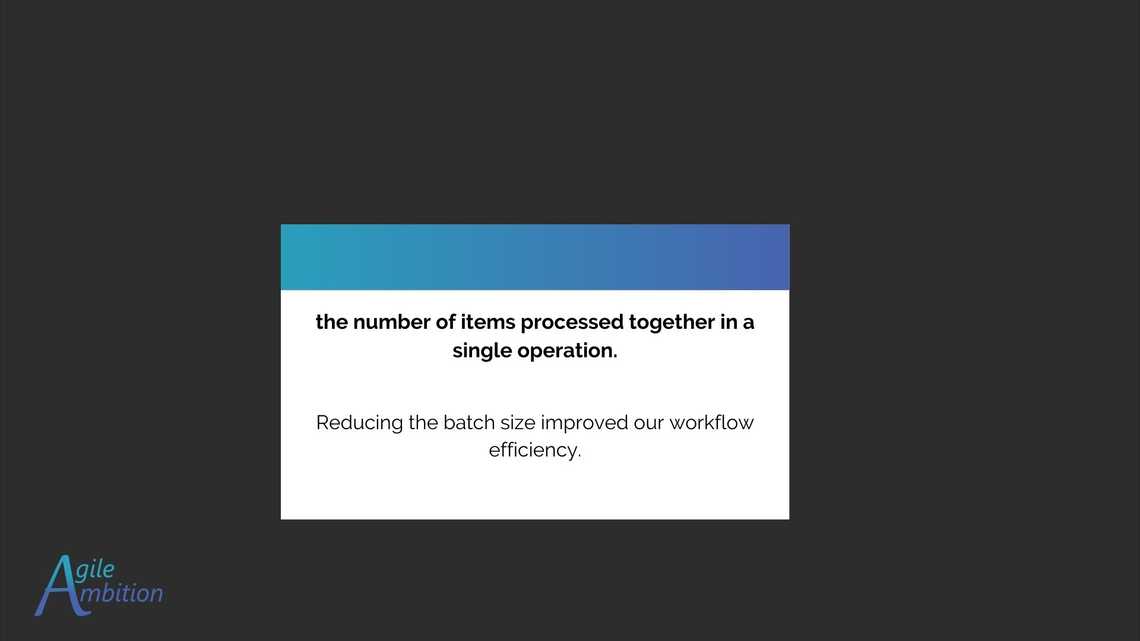Batch Size

Definition of Batch Size
Batch Size is the number of items processed together in a single operation.

Pronunciation Spelling
BATCH SY-zuh
Example Sentence
Reducing the batch size improved our workflow efficiency.
Discover Better Ways of Working
Significance
Agile practitioners need to be well-versed in the concept of “batch size” as it is integral to enhancing the agility and responsiveness of their workflow. Smaller batch sizes facilitate quicker feedback loops, enabling faster iterations and a more continuous flow of work, which is a core tenet of Agile approaches. This not only ensures efficiency but also allows for better risk management since potential issues affect a smaller portion of the project, making them easier to address without significant disruption.
Moreover, smaller batches help in maintaining high quality, as defects can be detected and remedied promptly, ensuring that the end product meets the desired standards. This approach aligns with the Agile emphasis on customer value, as it allows for the incremental release of features, thereby providing value to customers sooner and integrating their feedback into the development process. It also aids in preventing overload and promoting sustainable development practices within teams. Lastly, the predictability in delivery that comes with managing batch sizes is crucial for setting realistic timelines and managing stakeholder expectations, thus fostering a reliable and adaptable development environment.
Frequently Asked Questions (FAQs)
What Is Batch Size and Sprint Length?
The concept of batch size encompasses the unit count of work items, whereas sprint length sets the timebox for a work cycle. The interplay between them is critical for planning.
Batch size and sprint length are two pivotal elements in Agile planning that exhibit a reciprocal relationship; the batch size encapsulates the count of work items undertaken, while sprint length determines the allotted period for their completion. As such, a longer sprint length typically allows for a larger batch size, meaning more work items can be planned and executed. Conversely, planning for more work items necessitates a proportional extension in sprint length to ensure each task is given adequate time for thorough completion, reinforcing their symbiotic dynamic in project management.
With a fixed sprint length in place, it becomes the deciding factor for the number of work items a team can feasibly plan for within an iteration, ensuring that the scope of work aligns with the available time for execution.
What Is the Batch Size of Scrum?
Batch size in Scrum is usually synonymous with the Sprint Backlog - the Product Backlog Items planned for a Sprint. However, this is just one example of batch size; other forms also play a crucial role in efficiency.
Within a Sprint, items can accumulate in stages like the ‘to be released’ queue, where they are processed collectively. This batching, though potentially efficient, needs careful scrutiny. Scrum Teams should ensure such practices are deliberate and value-adding, as unintentional batching can inadvertently extend cycle times, delaying the delivery of customer value. The key lies in recognizing and optimizing these internal batch processes to align with the overarching goal of agility and rapid value delivery.
What Does Batch Size Mean in Kanban?
Batch size in Kanban quantifies the number of tasks processed together. However, it’s more than just a number; it’s a strategic lever that, when adjusted correctly, can dramatically improve workflow and team efficiency.
Why Is It Important for Teams To Understand the Optimum Batch Size for Their Work?
Teams must grasp their optimum batch size to ensure a smooth workflow. The right batch size can significantly reduce cycle times and enhance overall productivity, while the wrong size can lead to delays and waste.
Which Statement Is True About Batch Size in Agile?
“When there is flow, it means there are small batch sizes” is the most accurate statement of the four provided. This is because in Agile, having a continuous flow of work is greatly facilitated by smaller batch sizes. These smaller batches allow for quicker completion, more frequent feedback, and easier adaptability, which are key tenets of Agile methodologies. On the contrary, the other statements either misrepresent Agile principles or are not as directly aligned with Agile’s core focus on maintaining a steady, efficient flow of work.
1. When stories are broken into tasks it means there are small batch sizes
This statement isn’t necessarily true. Breaking stories into tasks is a common practice in Agile to organize and manage work more effectively. However, this doesn’t automatically imply small batch sizes. The batch size depends on how many of these tasks or stories are being worked on simultaneously.
2. Large batch sizes ensure time for built-in quality
This statement is misleading. In Agile, the emphasis is on continuous improvement and built-in quality at every step. Large batch sizes can actually hinder this process, as they often lead to longer lead times, reduced flexibility, and delayed feedback, which are contrary to Agile principles.
3. When there is flow it means there are small batch sizes
In Agile methodologies, a key goal is to achieve a continuous flow of work. Small batch sizes contribute to this by allowing work to move quickly and smoothly through the development process. Smaller batches are easier to manage, quicker to complete, and allow for faster feedback and iteration, which are essential aspects of Agile. This statement aligns well with the principles of Agile, where maintaining a steady flow of work is crucial.
4. Large batch sizes limit the ability to preserve options
While this statement holds some truth in the context of Lean principles, it’s not entirely accurate in the specific context of Agile. Agile methodologies do emphasize preserving options, but the primary issue with large batch sizes in Agile is that they can slow down the process, reduce flexibility, and delay feedback, which is contrary to Agile’s emphasis on adaptability and quick iterations. This statement, though relevant, is not as directly associated with the core principles of Agile as the statement about flow and small batch sizes.
Additional Resources
- When Doing Your Best Is The Worst Option
- Make Value Flow without Interruptions
- Practical Kanban: From Team Focus to Creating Value
- Applying Scrum with Kanban: A Pointless Book!
- The Principles of Product Development Flow
Share
Table Of Contents
Fuel an Idea
Every week, I break down complex ideas, strip away the fluff, and give you experiments to turn knowledge into skills.
If that’s worth a coffee, consider fueling the next big insight.
No pressure. No guilt trips. Just impact.
Buy Me a CoffeeQuick Links
Legal Stuff

